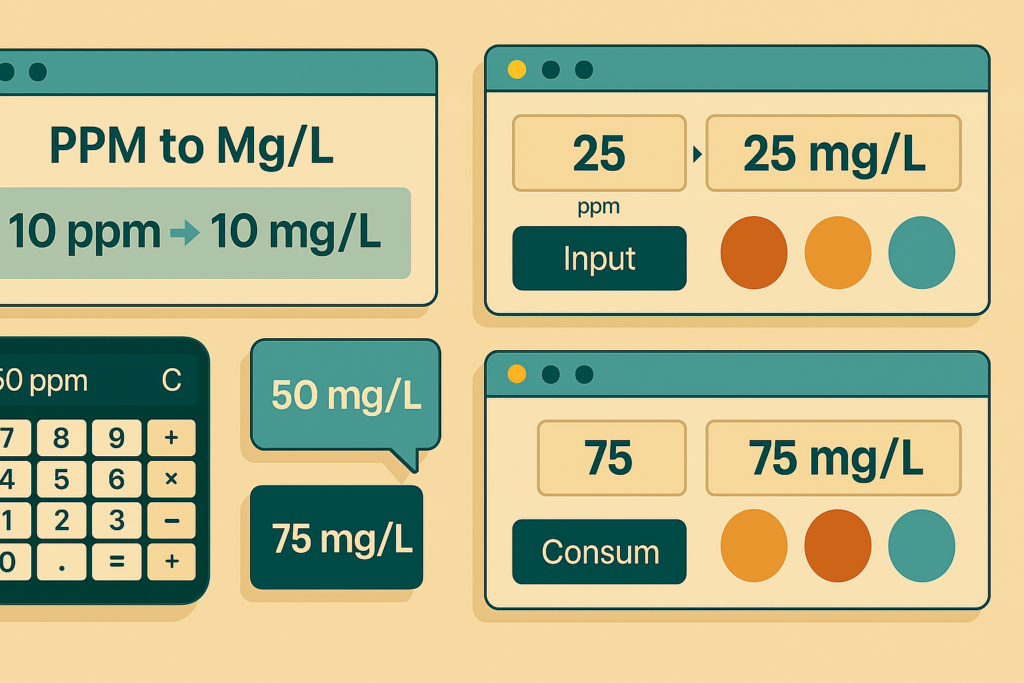Whether you’re in a laboratory, managing water quality for agriculture, or handling scientific data, converting ppm (parts per million) to mg/L (milligrams per liter) is a routine yet crucial task. While in most water-based cases 1 ppm ≈ 1 mg/L, manually converting multiple values can still be time-consuming and error-prone. That’s where online calculators come in.
In this article, we’ll explore five of the best free tools available to help you convert ppm to mg/L instantly. We’ll also walk through a real example, compare features, and explain when it’s still worth doing a manual check.
Why Using Online Tools Saves Time
Manual conversions are useful for learning and quick checks, but if you’re:
- Dealing with large datasets
- Working with non-aqueous solutions
- Needing precision down to decimal places
- Verifying lab test results
…then online converters are much faster and more reliable. They reduce the mental load, minimize human error, and can even adjust for solution density if required.
For professionals in environmental sciences, aquaculture, pharmaceuticals, or agriculture, these tools are a daily necessity.

Easily convert Parts Per Million (PPM) to Milligrams per Liter (mg/L), Micrograms per Cubic Meter (µg/m³), and Grams per Liter (g/L) with our free online tool. Fast, accurate, mobile-friendly—get instant results now.
The Top 5 Free ppm to mg/L Converters
Here’s a curated list of the most user-friendly, accurate, and free tools for ppm to mg/L conversion:
1. UnitConverters.net
URL: unitconverters.net
Why we like it:
- Clean interface with no ads
- Supports multiple unit conversions, not just ppm/mg/L
- Fast, accurate results with real-time calculations
Bonus feature: Includes reverse conversion (mg/L to ppm) on the same page.
2. CalculatorSoup
URL: calculatorsoup.com
Why we like it:
- Offers context-specific conversions for mass, volume, and molarity
- Allows entering different densities—great for non-water solutions
- Very useful for chemists or lab techs
Bonus feature: Gives formulas used behind the scenes, so it’s also a learning tool.
3. Aqua-Calc
URL: aqua-calc.com
Why we like it:
- Designed specifically for food and water industries
- Lets you input substance and temperature to adjust for density
- Provides data-rich results in multiple units
Bonus feature: Offers density tables for various chemicals and liquids.
4. RapidTables
URL: rapidtables.com
Why we like it:
- Super simple and intuitive design
- Includes definitions and formulas with examples
- Fast load times, minimal distractions
Bonus feature: Embedded ppm to mg/L formula with real-time result display.
5. Omni Calculator – ppm Converter
URL: omnicalculator.com
Why we like it:
- Stylish, modern UI
- Highly customizable inputs for different chemical scenarios
- Great for students and researchers
Bonus feature: Also supports ppm to mol/L and ppm to % conversions.
Feature Comparison: Interface, Precision & Flexibility
| Tool | Interface | Precision | Density Adjustment | Educational Value |
| UnitConverters | Clean & fast | ✅ High | ❌ Not available | ⭐⭐ |
| CalculatorSoup | Functional | ✅ High | ✅ Yes | ⭐⭐⭐⭐ |
| Aqua-Calc | Detailed UI | ✅ High | ✅ Yes | ⭐⭐⭐ |
| RapidTables | Minimalist | ✅ Good | ❌ Not available | ⭐⭐ |
| Omni Calculator | Modern UX | ✅ High | ✅ Yes | ⭐⭐⭐⭐ |
Takeaway:
If you want maximum customization for complex substances, CalculatorSoup or Omni Calculator is best. For quick conversions, UnitConverters or RapidTables offers the fastest experience.
Step‑by‑Step: Using UnitConverters.net
Let’s walk through a basic example using UnitConverters.net.
Goal: Convert 50 ppm to mg/L in water.
Step 1:
Visit UnitConverters.net
Step 2:
In the input box, type 50 under “ppm”.
Step 3:
The tool instantly displays:
Result: 50 ppm = 50 mg/L
Step 4:
To reverse the conversion, just click on “mg/L to ppm” at the bottom of the page.
Note: Since we’re dealing with water (density ~1 g/cm³), the 1:1 conversion applies.
How to Verify Accuracy
Even the best tools rely on accurate input. To verify your results:
- Use multiple tools – Try CalculatorSoup and Omni Calculator for cross-verification.
- Check the formula:
- For water:
ppm=mg/L\text{ppm} = \text{mg/L}ppm=mg/L
- For other liquids:
mg/L=ppm×(density of solution in g/mL1)\text{mg/L} = \text{ppm} \times \left(\frac{\text{density of solution in g/mL}}{1}\right)mg/L=ppm×(1density of solution in g/mL)
- Look for decimal rounding – Some tools round off early. Use ones that display at least 4 decimal places when needed.
When a Manual Check Is Still Important
While calculators are great, there are times when you need to go old-school:
- Academic exams or lab reports that require showing your work
- Non-water solutions (e.g., oil, alcohol) where density matters
- Cross-checking tool errors or rounding inconsistencies
- When working offline without internet access
In these cases, knowing the basic formula and assumptions helps ensure you’re not blindly trusting a tool.
Final Thoughts
Online tools and calculators have made ppm to mg/L conversion faster, more reliable, and accessible for everyone—from students to scientists. Whether you need precision, simplicity, or educational support, the five free tools listed above will help you save time and eliminate guesswork.
For fast water-based conversions, UnitConverters.net or RapidTables is all you need. For advanced chemical calculations or density-sensitive results, CalculatorSoup and Omni Calculator are your best bet.

